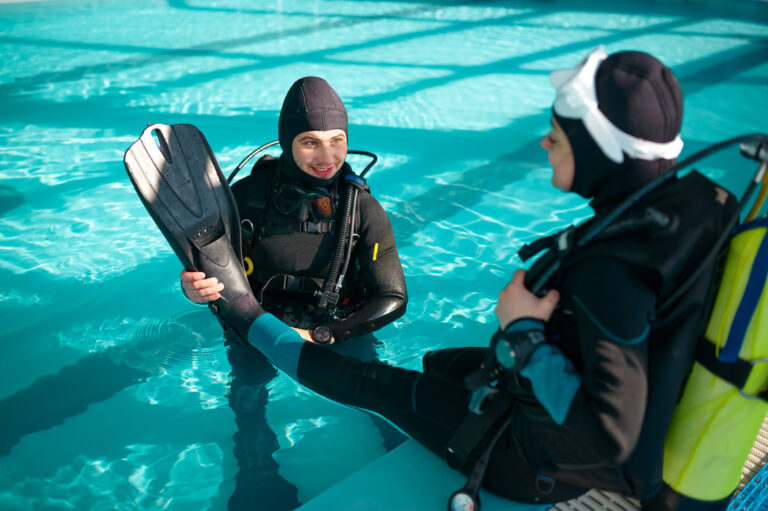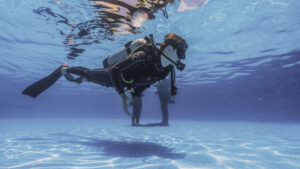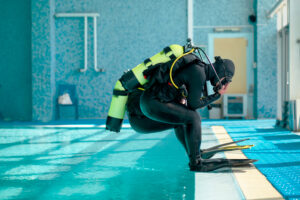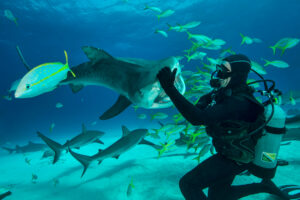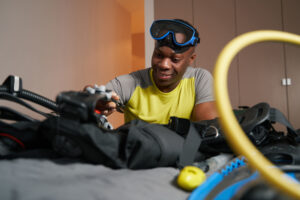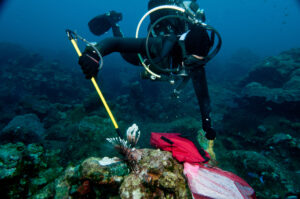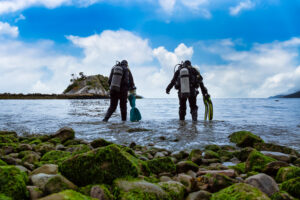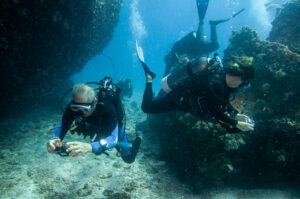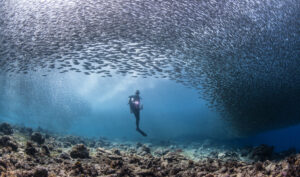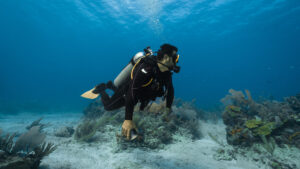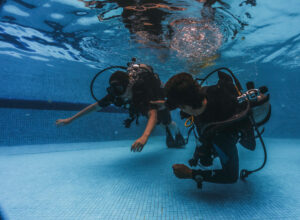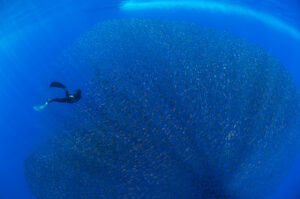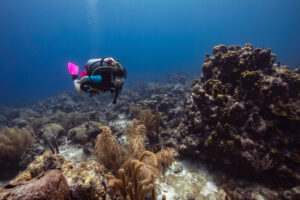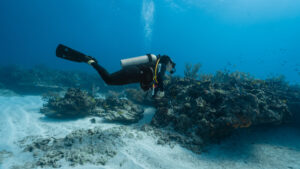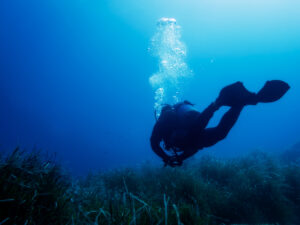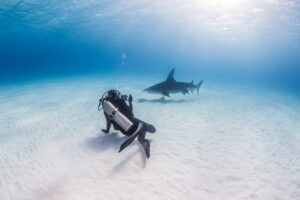What is Sidemount Diving?
Sidemount diving is a scuba equipment configuration where diving cylinders are placed along the diver’s sides rather than on the back, as is typical in traditional backmount setups. This system allows for enhanced flexibility, mobility, and safety while underwater. The cylinders are positioned below the shoulders and extend along the hips, giving divers more freedom of movement compared to conventional systems. Divers appreciate sidemount configurations for their ability to streamline the diver’s profile, which is particularly advantageous in environments with tight spaces like caves, but the setup is also widely used in other forms of diving, from recreational to professional.
History and Development
The history of sidemount diving is closely linked to the challenges encountered in technical and cave diving. The narrow spaces and intricate passages found in cave systems posed significant difficulties for divers using traditional backmounted equipment. Sidemount configurations emerged as a solution, allowing divers to navigate these tight areas more easily. Early pioneers of sidemount diving were often cave explorers who needed to minimize the risk of getting stuck or damaging equipment in confined spaces. The streamlined profile of sidemount diving gear reduced the risk of entanglement and provided a safer, more efficient way to explore cave systems.
As sidemount diving gained popularity among cave divers, its advantages became apparent to a broader audience of technical divers. These divers often required multiple gas cylinders to accommodate extended dive times, and sidemount allowed for easier access and management of these cylinders. Over time, sidemount diving moved beyond its origins in cave and technical diving. By the late 20th century, it was being adopted by a wider range of diving communities, including recreational and professional divers who appreciated the flexibility and comfort the configuration offered.
The evolution of sidemount diving has been marked by continuous improvements in equipment design. Early configurations were often makeshift systems adapted from other gear, but as demand grew, manufacturers began producing dedicated sidemount harnesses and accessories. Today, many divers use sidemount setups in open water environments, and it has become an integral part of the diving world.
Equipment Configuration
In a typical sidemount diving configuration, the diver uses one or two cylinders, each equipped with its own regulator and pressure gauge. This provides a high level of redundancy, which is a significant safety advantage. Should one system fail, the diver can switch to the other, ensuring a continuous supply of breathing gas. The cylinders are securely attached to the diver’s body via a specially designed harness. This harness includes clips, D-rings, and bungee cords, which help to keep the cylinders in place while allowing for easy adjustment.
The positioning of the cylinders along the sides of the body provides a lower profile compared to backmounted systems. This reduces drag and improves the diver’s ability to maneuver in tight spaces, such as wrecks or caves. The diver’s buoyancy control device (BCD) is often integrated into the sidemount harness. This allows for greater control over trim and buoyancy, which is essential for maintaining a streamlined position in the water. Many divers also use a weight system that can be adjusted to suit their needs, ensuring proper balance and stability throughout the dive.
One of the key elements of sidemount diving is the independent management of gas supplies. Each cylinder operates as a separate system, allowing the diver to monitor and switch between tanks as needed. This is particularly useful in technical dives where multiple gas mixtures might be required. The diver’s ability to reach and manipulate the valves on each cylinder is another advantage of the sidemount configuration, as it simplifies gas switching and equipment checks during the dive.
Advantages of Sidemount Diving
Accessibility and Transport
Sidemount diving offers several advantages when it comes to the transportation of equipment. Since the cylinders are not permanently attached to the harness, divers can carry them separately and attach them once they are in the water. This can be a major benefit during shore dives where the diver needs to traverse challenging terrain before reaching the entry point. Carrying cylinders one at a time reduces the strain on the diver and makes it easier to transport the necessary equipment to the water’s edge.
The ease of attaching and detaching cylinders also makes sidemount diving convenient for dive sites where access is limited, such as boat dives with confined spaces. The flexibility of this configuration simplifies the logistics of getting in and out of the water, especially when compared to the bulkier and less flexible backmount setups. This has made sidemount diving particularly popular among divers who need to transport their gear over long distances or challenging terrain.
Flexibility and Comfort
Underwater, sidemount diving offers a level of comfort and flexibility that is unmatched by other configurations. The cylinders can be moved forward or backward along the diver’s body, allowing for easier access to valves and regulators. This flexibility is particularly useful when adjusting buoyancy or in the event of an emergency where quick access to the gas supply is essential. In addition, the sidemount configuration allows the diver to maintain a more horizontal position in the water, which is ideal for streamlining and reducing drag.
Many divers find that sidemount diving is more comfortable than backmount diving, particularly during longer dives. The absence of heavy cylinders on the diver’s back reduces strain on the spine and shoulders, making it easier to maintain a comfortable position throughout the dive. This setup can be especially beneficial for divers with physical limitations or those who experience discomfort with traditional backmounted systems.
Safety and Redundancy
One of the most significant safety advantages of sidemount diving is the redundancy it offers. Each cylinder operates independently, with its own regulator, pressure gauge, and gas supply. This allows the diver to manage gas consumption from each cylinder separately and provides a backup in the event of equipment failure. In technical and cave diving, where the risks are higher, this level of redundancy can be a lifesaver.
Sidemount diving also enhances safety by giving divers better control over their equipment. The positioning of the cylinders allows for easy access to valves, which simplifies tasks like gas switching and equipment checks. In an emergency, the diver can quickly isolate or shut off a faulty cylinder and continue the dive using the remaining gas supply. This feature is particularly important in environments where a direct ascent to the surface is not possible, such as caves or wrecks.
Disadvantages and Considerations
Despite its many advantages, sidemount diving comes with its own set of challenges. It requires specialized training and practice to become proficient in managing the equipment. The diver must learn new skills, such as cylinder management, valve drills, and buoyancy control, which can be more complex than in traditional backmount diving. For many divers, this learning curve can be steep, and it takes time and effort to master the techniques required for safe sidemount diving.
Additionally, the sidemount setup can be more prone to entanglement if not properly secured. The cylinders and hoses must be carefully rigged to avoid creating snag points. This is particularly important in environments where there are obstacles like fishing lines, cables, or debris. Divers must be diligent in checking their equipment and ensuring that everything is properly stowed to minimize the risk of entanglement.
Another consideration is the potential for increased task loading. Managing two independent gas systems requires careful attention, especially during long or complex dives. The diver must be proficient in switching between cylinders, monitoring gas levels, and adjusting buoyancy, all while maintaining awareness of the dive environment. This can be overwhelming for less experienced divers or those new to sidemount diving.
Training and Certification
Given the unique skills and techniques required for sidemount diving, specific training is necessary. Many diving organizations, including PADI, SSI, and TDI, offer specialized courses designed to teach divers how to safely and effectively use a sidemount configuration. These courses typically cover topics such as equipment setup, gas management, buoyancy control, and emergency procedures. Divers are taught how to attach and detach cylinders in the water, perform valve drills, and manage potential equipment failures.
Sidemount diving courses usually involve both theory and practical sessions. In the classroom, divers learn about the principles of sidemount diving, including the benefits and limitations of the configuration. During the practical sessions, divers practice assembling and adjusting their gear, as well as performing underwater drills to improve their proficiency in handling sidemount equipment.
For divers interested in technical or cave diving, sidemount training is often a prerequisite. Many technical diving courses require divers to be proficient in sidemount techniques before they can progress to more advanced levels. Even for recreational divers, sidemount training provides valuable skills that can improve overall diving safety and enjoyment.
Equipment Selection and Setup
Choosing the right equipment is a crucial aspect of sidemount diving. The centerpiece of the configuration is the sidemount harness, which must be comfortable, adjustable, and durable. The harness should fit snugly to the body and provide secure attachment points for the cylinders. D-rings on the harness allow the diver to adjust the position of the cylinders, while bungee cords help keep the cylinders close to the body to reduce drag and improve streamlining.
Cylinders used in sidemount diving are typically smaller and lighter than those used in backmount configurations. Many divers prefer aluminum cylinders, as they are more buoyant and easier to handle. However, steel cylinders are also used, particularly in technical diving, where divers may need to carry larger volumes of gas. Each cylinder is equipped with its own regulator, first stage, and pressure gauge, ensuring that the system remains independent and redundant.
The buoyancy control device (BCD) plays a critical role in sidemount diving, as it must provide enough lift to support the weight of the cylinders and the diver. Many sidemount BCDs are integrated into the harness, allowing for a streamlined and comfortable configuration. Divers must also carefully select their weight system, as proper weighting is essential for maintaining good trim and buoyancy control.
Skills and Techniques
Sidemount diving requires a different set of skills compared to traditional backmount diving. One of the primary techniques divers must learn is how to enter and exit the water while managing the cylinders. In many cases, cylinders are attached in the water, rather than on land, to reduce the strain of carrying the equipment. This technique is particularly useful in shore dives or boat dives with limited space.
Buoyancy control is a critical skill in sidemount diving, as the position of the cylinders affects the diver’s trim. The diver must be able to adjust the position of the cylinders to maintain proper balance and control. This may involve sliding the cylinders forward or backward along the body or adjusting the tension of the bungee cords. A well-balanced sidemount diver will have a horizontal trim, which reduces drag and makes it easier to move through the water efficiently.
In addition to buoyancy control, sidemount divers must be proficient in emergency procedures. This includes managing gas failures, sharing gas with a buddy, and performing controlled emergency swimming ascents. Divers must also be comfortable switching between regulators during the dive to balance gas consumption from each cylinder.
Key Takeaways
Sidemount diving is a versatile and effective configuration that enhances flexibility, safety, and comfort. Originating in the technical and cave diving communities, it has become widely adopted by divers of all levels. While sidemount diving requires specialized training and practice, its benefits make it an appealing option for recreational and professional divers alike.

